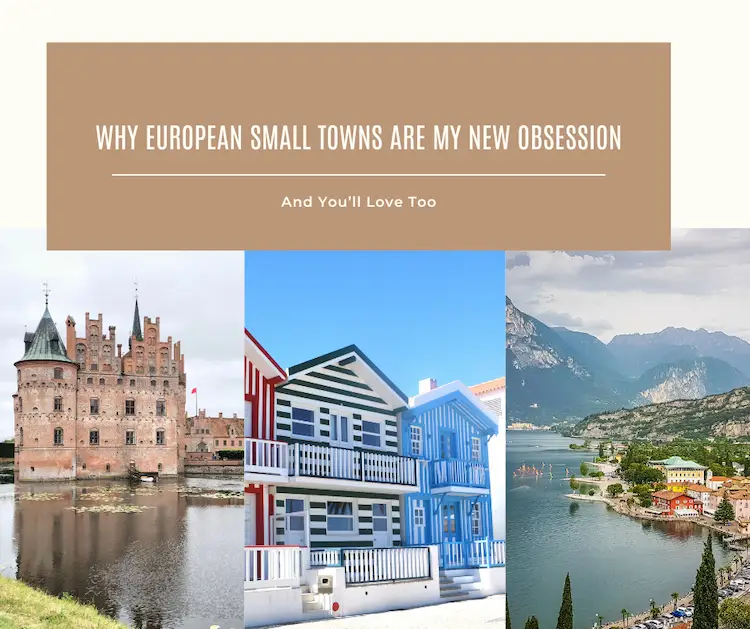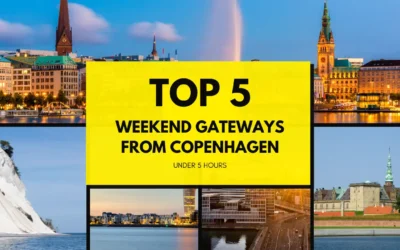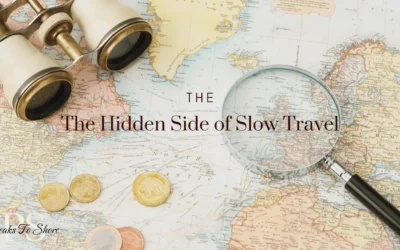Big cities are amazing, right? They’re full of life, with cool places to visit and tons of pictures to take for Instagram. I’ve spent years running around cities like Paris, Copenhagen, and Lisbon—eating croissants, biking along canals, and sipping coffee in cute neighborhoods. But after a while, I got a bit tired of the rush. I wanted something different. Not less exciting, just… calmer.
That’s when I found the magic of Europe’s small towns. These places are so special. You won’t find them on every travel blog or in busy tourist spots. Instead, you’ll see colorful houses with little windows, old folks waving hello like you’re a friend, and tiny bakeries where they make bread the same way their grandparents did. It’s like stepping into a storybook, and I’m hooked.
I’m starting a new series all about these amazing small towns in Europe. They don’t always get the attention they deserve, but they’ll steal your heart. If you’re someone who loves to travel, works online from anywhere, or dreams of moving somewhere new and affordable—this is for you. These towns aren’t just pretty; they teach you how to slow down and enjoy life.
Today, I’ll share my favorite small towns in three countries I’ve visited a lot: Denmark, Portugal, and Italy. Each place showed me something new about taking life easy and feeling happy. Let’s go explore them together!
Denmark: Cozy Vibes in Quiet Places
Everyone talks about Copenhagen, and I get why—it’s awesome! But there’s a whole other side to Denmark that’s just as great. The countryside is so peaceful, with little towns where everyone knows each other, and the scenery looks like a painting. It’s where you really feel hygge—that Danish word for feeling cozy and happy—without all the city noise.
1. Ærøskøbing: A Cute Little Town on an Island
📍 Location: Ærø Island, Southern Denmark
Imagine a town that looks like a fairytale. That’s Ærøskøbing. It’s on a small island called Ærø, with tiny streets made of stones, houses painted in soft colors like pink and yellow, and a harbor that turns all golden when the sun sets. It feels like a place where a princess might live!
Danes love coming here for romantic trips or even weddings because it’s so pretty and quiet. But it’s not overrun with tourists. There’s one main street with a few shops, a little ice cream place run by a family, and a harbor where local fishermen hang out more than visitors do.
I went there one weekend after a friend told me I had to see it. I took a ferry from a town called Svendborg—it was a short ride, and the sea air felt so fresh. When I got there, I rented a bike for the day (it was super cheap, like 50 DKK). I rode around the island in less than an hour, passing fields of flowers and little beaches. At night, I sat by the harbor with a hot chocolate, watching the sunset. It was so peaceful, like the whole world slowed down just for me.
Why you’ll love it:
- It’s super calm and feels like a big hug—perfect for relaxing.
- Great if you want to write, draw, or just unplug from your phone for a bit.
- You can bike everywhere, and it’s easy because the island is flat.
My Tip: Stay at a cute guesthouse like Pension Vestergade—it’s cozy and costs about 600 DKK a night. Spring or early fall is the best time to go because it’s not too crowded, and the weather is nice.
Want to know more about living in Denmark? Check out my post on what it’s really like to move there.
For more ideas on visiting Denmark, look at Visit Denmark’s website.
2. Ribe: Denmark’s Oldest Town
📍 Location: Jutland
Ribe is like stepping into a history book—it’s over 1,300 years old! That makes it the oldest town in Denmark. The streets are full of old houses and a big cathedral with a shiny golden top. There’s even a museum about Vikings, which was so cool to see.
But Ribe isn’t just stuck in the past. People live here, and it’s got a fun mix of old and new. There are students from a nearby school, artists, and people who love making things. Plus, there’s a huge nature spot nearby called the Wadden Sea—it’s so special that it’s on a UNESCO list. I saw seals swimming there and birds flying in big groups. It was amazing.
I went in spring, and it was the perfect time. The weather was cool but sunny, and there weren’t many tourists. I walked along the Wadden Sea with a local guide who told me all about how the ocean moves in and out, and how birds come from far away to visit. At night, I sat in a little café with a cup of hot cocoa, talking to people who lived there. They were so friendly and loved that I wanted to learn about their town.
Why you’ll love it:
- It’s full of history, like walking through a Viking story.
- The Wadden Sea is great for nature lovers—you can see animals and take awesome pictures.
- It feels both old and new, so there’s something for everyone.
My Tip: Go in spring for pretty light in the evenings—it’s great for photos. There’s also a festival in August, but it gets busier then.
Portugal: Taking It Easy by the Ocean
Portugal isn’t just about Lisbon or Porto, even though those cities are awesome. The real magic happens when you go to the smaller places. These towns feel like they belong to the land, with white houses, green hills, and people who make you feel so welcome. It’s all about slowing down and enjoying the simple things.
1. Monsaraz: A Cute Town on a Hill
📍 Location: Alentejo
Monsaraz is like a dream. It’s a tiny town on a hill in the Alentejo region, with white houses, stone streets, and an old castle that looks over fields of olive trees and grapevines. It feels so far away from busy city life, like time forgot about it.
I stayed in a little guesthouse owned by an older couple. They made me breakfast every morning with bread, jam, and eggs—all from their own garden! It was so quiet, except for the sound of sheep in the distance or a tractor going by. But there was plenty to do. I went hiking in the woods nearby, tasted yummy wines at a vineyard, and even went kayaking on a lake called Alqueva. At night, the stars were so bright—they looked like they were floating on the water. Oh, and it was super affordable—my guesthouse was only 40 euros a night, even in summer!
Why it’s special:
- It doesn’t cost a lot, even when it’s busy in summer.
- Good for people who work online, but you might need your own Wi-Fi plan.
- The sunsets are the best I’ve ever seen—perfect for pictures.
My Tip: Go in late spring or early fall for nice weather and fewer people. Bring a notebook or camera—you’ll want to capture everything!
Thinking about moving to Portugal? Here’s my post on what it’s really like for expats.
Want to learn more about Alentejo? Lonely Planet has a great guide.
2. Tavira: A Quiet Spot in the Algarve
📍 Location: Eastern Algarve
The Algarve can get pretty busy with tourists, but Tavira is different. It’s a little town by a river, with old buildings from a long time ago, like from the Moors and Romans. The beaches nearby aren’t crowded, and it feels like the real Algarve—the kind locals love.
I stayed in Tavira for a week, working from a sunny apartment I found on Airbnb. I’d start my day with a strong coffee on the balcony, work on my laptop for a bit, then go swim in the Ria Formosa lagoon during lunch. It was so clear and warm! The people there were so nice—fishermen waved at me, and the lady at the café told me stories about the town while I ate grilled fish. Time felt so slow, in a good way, like I could just enjoy every moment.
Why it’s special:
- It’s a quieter part of the Algarve, with beaches that aren’t packed.
- The lagoon is full of birds like flamingos, and you can kayak there too.
- It’s great if you work online because lots of places have good Wi-Fi.
My Tip: Visit in April, May, or September for warm weather without the crowds. Rent a bike to ride around the salt pans—you might see flamingos!
Italy: So Much More Than the Big Spots
Everyone knows about Tuscany and the Amalfi Coast in Italy, but the small towns are even better sometimes. They’re all so different, from perfect little villages to places that feel super old, and they’re not as crowded as the famous spots.
1. Pienza: A Pretty Town in Tuscany
📍 Location: Tuscany
Pienza is like a postcard come to life. It was built a long time ago to be the “perfect town,” and it really feels that way. The buildings are made of golden stone, and there are big open views of the countryside, with fields of sunflowers everywhere.
I loved walking around here. The air smelled like cheese—there’s a special kind called pecorino that they make in Pienza—and I could see hills stretching out forever. I took long walks through the fields, ate fresh pasta at a little restaurant where the owners were so sweet, and tried local wines that were amazing. It felt so calm, like I could stay forever.
Perfect for:
- Couples or people traveling alone who want a quiet, pretty place.
- Anyone who likes to write or take photos—it’s so inspiring.
- If you love cheese and wine, you’ll be in heaven!
My Tip: Go in spring or fall for nice weather and fewer people. Stay at Hotel Residence San Gregorio—it’s right in town but still peaceful, and rooms start at 80 euros a night.
Learn more about Pienza on Discover Tuscany’s website.
2. Matera: A Super Old Town in Italy
📍 Location: Basilicata
Matera is like nothing I’ve ever seen. It’s built into cliffs, with houses made of caves called sassi. It’s one of the oldest places in the world where people still live! It looks a bit like the moon, but it’s so beautiful.
I walked through little paths and saw churches carved into the rock with old paintings inside. I stayed in a hotel that was actually a cave—it was so cool, and it even had Wi-Fi! There’s a lot of art stuff going on, with galleries and events, and the food was so good—pasta with veggies that tasted like it was made with love. It felt old but also new, which I loved.
Why you should go:
- Not many tourists know about it, so it feels special.
- It’s a mix of old history and new, fancy stuff like cool hotels.
- The food is amazing, with big, hearty meals you’ll never forget.
My Tip: Visit in late spring or early fall because summer can get really hot. Stay at Sextantio Le Grotte della Civita—it’s a cave hotel, and rooms start at 150 euros a night.
Read more about Matera on the UNESCO website.
Tips for Visiting Small Towns (You’ll Be Glad You Know These)
Here are some things I learned while traveling to these small towns—they’ll make your trip so much better:
- 🌐 Internet isn’t always great: If you work online, check if your place has good Wi-Fi before you book. Some towns like Tavira have it, but others like Ærøskøbing might not. You can get a local SIM card if you need to.
- 🍝 Restaurants close sometimes: In Italy and Portugal, lots of places shut down between lunch (around 2–5PM) and dinner (7–8 PM). Make sure to eat early or bring a snack so you don’t get hungry.
- 💬 Learn a few words: People might not speak much English in small towns. Knowing simple words like “thank you” (like “obrigado” in Portugal or “grazie” in Italy) makes people smile and helps you out.
- 🚌 Getting around can be tricky: Buses and trains don’t come as often as in big cities. Renting a car is the best way to get around, especially in places like Alentejo or Jutland. You can find cars on Auto Europe.
FAQs: Questions About Small Town Travel in Europe
Q: Are small towns safe if I’m traveling alone?
Yes, they’re really safe! I felt more comfortable in small towns than in some big cities. Just be smart like you would anywhere—don’t leave your stuff lying around, and stick to well-lit places at night. I felt so at ease walking around Pienza by myself.
Q: Can I live in these towns if I work online or want to move there?
Definitely, but you need to plan a bit. You’ll need good Wi-Fi, so ask about it before you rent a place. A car helps too because buses aren’t always around. These towns are awesome if you like a slow, quiet life. Rent can be cheap—like 500–800 euros a month. You’ll also need to check visa rules, like Portugal’s D7 visa or Denmark’s Green Card.
Q: Do people in small towns like visitors?
Most of them do! They’re usually really nice if you’re friendly and curious. In Ærøskøbing, a lady invited me to a bake sale after we talked for a bit. Just learn a few words in their language and don’t act too loud, and they’ll be happy to have you.
Q: When’s the best time to visit these towns?
Spring (April to June) and fall (September to October) are the best. The weather’s nice, there aren’t many tourists, and everything looks so pretty—like the flowers in Denmark or the leaves in Italy. Summer has fun festivals, but it’s busier. Winter can be cozy with Christmas markets, but it gets dark early.
Q: Are these towns good for a tight budget?
Yes, they’re much cheaper than big cities! A place to stay in Monsaraz or Pienza costs 40–80 euros a night, and meals are about 10–20 euros. Getting around might add 20–50 euros a day if you take a bus or rent a car. So, a weekend trip could be 100–200 euros. Bring some cash because lots of small places don’t take cards.
Final Thoughts: Why I Love These Towns So Much
There’s something so special about going to a place where time feels slower, where people smile more, and where every little street has a story to tell. These small towns might not be all over TikTok or Instagram, but they stay in your heart way longer than a quick city trip. I’ll never forget watching the sunset in Ærøskøbing, eating breakfast with fresh jam in Monsaraz, walking through sunflowers in Pienza, or exploring caves in Matera. They taught me to take my time and enjoy the little things.
What about you?
- Do you like big cities better, or are you more into quiet villages?
- Have you been to a small town that you loved?
- Would you ever want to live in a place like this someday?
Tell me in the comments—I’d love to hear what you think! Or share this with a friend who’d love a small-town trip—they might thank you for it.
I’m going to keep writing about small towns in other places like France, Germany, and the Baltics, so stick around for more. Let’s keep finding these hidden gems in Europe, one cozy spot at a time!
—







0 Comments